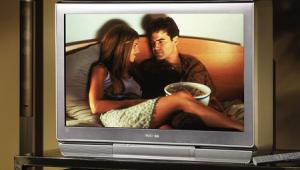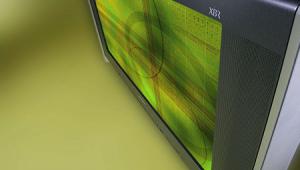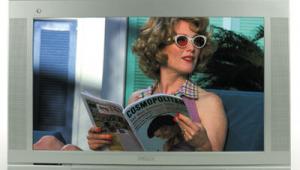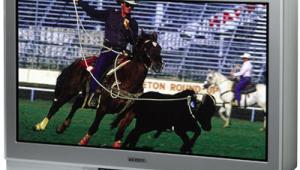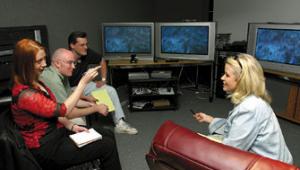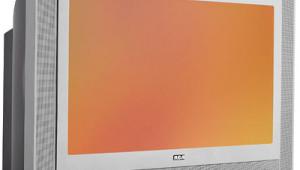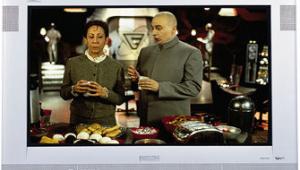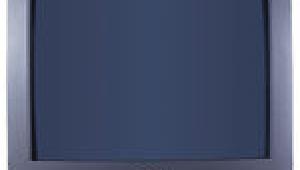Face Off: The Bridge on the River DTV
Bridge technology. I almost hate to use the phrase, since it undoubtedly originated on the PowerBook of some Madison Avenue hack. Still, the phrase works so well because we need so much right now. One cannot dabble in technology these days without instantly becoming familiar with the concept of bridging. We don't have it quite as bad as our cohorts in the computer industry, but (whether we like it or not) the grand digital-television experiment has put us all squarely in the gap between the present and the future of video. Sure, you could resist, as so many of us have been tempted to do. But your trusty old television is going to look pretty funny in 2006, when all it coughs up are 500 channels of blank screen. I wouldn't hold out hope that the FCC will balk on their blackout deadline for the analog transmissions. Word is that the analog portion of the spectrum has already been whacked up amongst the bandwidth-hungry cellular companies, which are willing to pay for it. Pop quiz: Who do you think the FCC wants in that space five years from now—television broadcasters (who they've been berating for some time now about dragging their feet on the digital transition and who don't pay a penny for the space) or cellular companies that are going to swoop in, drop a lot of cash, and swoop out with their bandwidth . . . no muss, no fuss. The first person to answer right wins a free chance to buy a new TV (and some expanded cellular service, too).
No need to panic, though. Part of our goal with this Face Off is to show that buying a digital TV doesn't have to be nearly as arduous—or as expensive—as some would have you believe and that the payoff can be immediate. We, after all, are consumers just like you. I know some of you have the erroneous impression that our living rooms are like A/V pirates' lairs, stuffed to capacity with ill-gotten home theater booty, and that we use extra plasma screens for coffee tables and rear-projection TVs for box springs. Unfortunately, that's not the case. Thus, we bring you our not-too-expensive-bridge-TV Face Off, with five DTV-ready combatants from Sony, Panasonic, RCA, Samsung, and Princeton Graphics—all of which hover around the $2,000 price range. You'll never hear us say two grand is cheap, but relativity is the key. You could pay a lot more for a DTV-ready set. While you'll obviously pay less for an analog TV of commensurate quality, it may not be as much less as you think—and the fact that the set will be, in many ways, obsolete long before the end of its useful life doesn't really constitute a good return on your money.
So, as this is more of an Everyman's TV Face Off, I set out to choose my crew accordingly. Originally, the illustrious panel was to be video-guru-free, including myself (aka the audio guy), editor Maureen Jenson (aka the boss), and studio manager Geoff Morrison (aka the rookie). In-house video guru Mike Wood was only added after he threatened to cough on us and give us all the flu he was nursing at the time. Of course, I jest—we actually dragged the poor guy from his deathbed to make sure we didn't blow up anything, and we got him to participate under the false pretense of a free lunch, which we knew he wouldn't be able to keep down anyway. Off-site video guru Ron Williams showed up under protest, ranted and raved at the screens for a while, and then sat down to quietly share his valuable opinions with us. Even though Maureen, Geoff, and I know a bit more about video than we let on, it ended up being a very well-balanced group.
For the record, the combatants are 32-inch, direct-view, DTV- or HDTV-ready sets with a 4:3 aspect ratio—except for the Samsung, which is a 30-inch widescreen set. Not all of the sets had internal line doublers, but they were all capable of a 31.5-kilohertz horizontal scan rate, which makes them compatible with progressive-scan DVD players—all of which do their own internal line doubling for the progressive image, so your TV only needs to be able to keep up. For the side-by-side portion of our demo, I ran the same composite video signal to all five sets from a Pioneer DV-AX10 DVD player through an Extron splitter, as well as standard- and high-def broadcast signals from the RCA DTC100 HDTV tuner/DBS receiver and Panasonic TU-DST50 HDTV tuner. Then, I ran progressive and interlaced DVD signals to one set at a time through the component outputs of the Pioneer player. I did the setup in two stages: first using the Video Essentials DVD and later using a more-advanced Philips test generator. The first setup procedure is a more-common method of TV calibration, while the second is more absolute. After all, the VE disc has to be played through a player, even the best of which will introduce some measure of video editorialization into the equation.
